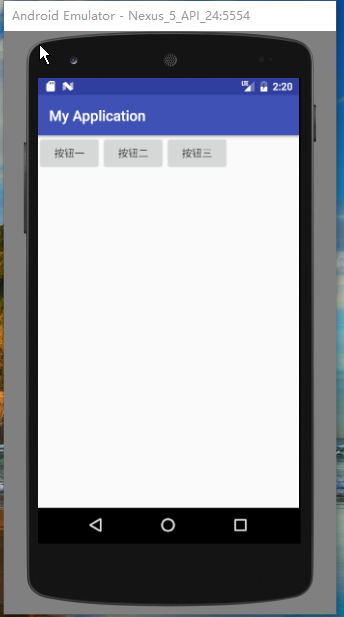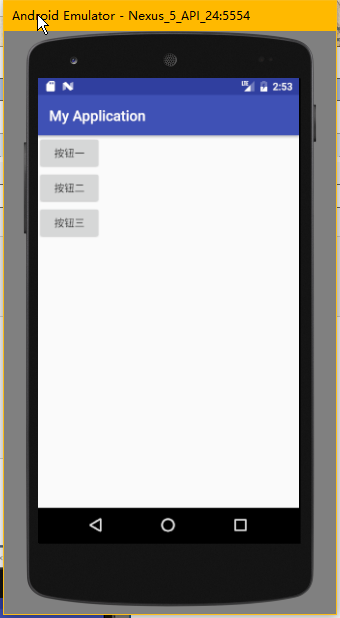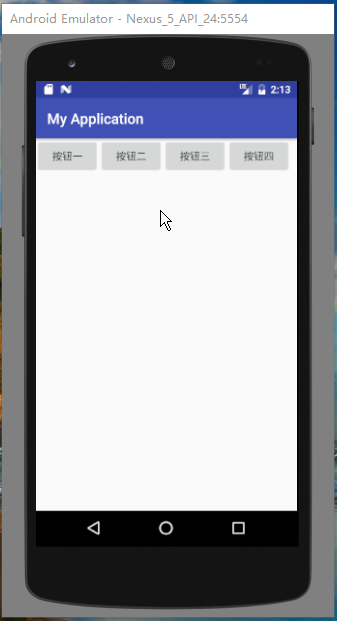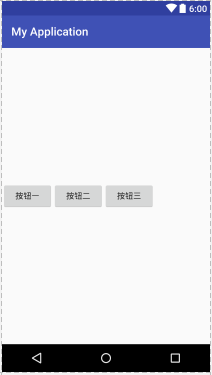Android布局管理详解(1)—— LinearLayout 线性布局
Android的布局方式共有6种,分别是LinearLayout(线性布局)、TableLayout(表格布局)、FrameLayout(帧布局)、RelativeLayout(相对布局)、GridLayout(网格布局)以及AbsoluteLayout(绝对布局)。
本次主要介绍 LinearLayout 线性布局,其余布局留待以后介绍。
线性布局由 LinearLayout 类来代表, LinearLayout 可以控制各组件横向或纵向排列。
LinearLayout 常用属性介绍
1. android:orientation
设置布局管理器内组件的排列方式,可设置为 horizon (水平排列)、vertical (垂直排列)。
<?xml version="1.0" encoding="utf-8"?>
<LinearLayout xmlns:android="http://schemas.android.com/apk/res/android"
android:orientation="horizontal"
android:layout_width="match_parent"
android:layout_height="match_parent">
<Button
android:id="@+id/btn1"
android:layout_width="wrap_content"
android:layout_height="wrap_content"
android:text="@string/btn1"/>
<Button
android:id="@+id/btn2"
android:layout_width="wrap_content"
android:layout_height="wrap_content"
android:text="@string/btn2"/>
<Button
android:id="@+id/btn3"
android:layout_width="wrap_content"
android:layout_height="wrap_content"
android:text="@string/btn3"/>
</LinearLayout>
上述代码设置了三个按钮(Button),第 3 行代码设置其排列方式为 horizon 水平排列,效果图如图 1:
图 1 : 图 2 : 图 3 :



将上述代码的第 3 行中 orientation 的值由 horizon 改为 vertical (如下代码),则按钮的排列方式变为垂直排列 ,如图 2
<?xml version="1.0" encoding="utf-8"?>
<LinearLayout xmlns:android="http://schemas.android.com/apk/res/android"
android:orientation="vertical"
android:layout_width="match_parent"
android:layout_height="match_parent">
<Button
android:id="@+id/btn1"
android:layout_width="wrap_content"
android:layout_height="wrap_content"
android:text="@string/btn1"/>
<Button
android:id="@+id/btn2"
android:layout_width="wrap_content"
android:layout_height="wrap_content"
android:text="@string/btn2"/>
<Button
android:id="@+id/btn3"
android:layout_width="wrap_content"
android:layout_height="wrap_content"
android:text="@string/btn3"/>
</LinearLayout>
注意: Android 的线性布局不会换行,当组件一个挨着一个的排列到头之后,剩下的组件将不会被显示出来
例:
<?xml version="1.0" encoding="utf-8"?>
<LinearLayout xmlns:android="http://schemas.android.com/apk/res/android"
android:orientation="horizontal"
android:layout_width="match_parent"
android:layout_height="match_parent">
<Button
android:id="@+id/btn1"
android:layout_width="wrap_content"
android:layout_height="wrap_content"
android:text="@string/btn1"/>
<Button
android:id="@+id/btn2"
android:layout_width="wrap_content"
android:layout_height="wrap_content"
android:text="@string/btn2"/>
<Button
android:id="@+id/btn3"
android:layout_width="wrap_content"
android:layout_height="wrap_content"
android:text="@string/btn3"/>
<Button
android:id="@+id/btn4"
android:layout_width="wrap_content"
android:layout_height="wrap_content"
android:text="@string/btn4"/>
<Button
android:id="@+id/btn5"
android:layout_width="wrap_content"
android:layout_height="wrap_content"
android:text="@string/btn5"/>
</LinearLayout>
上述代码定义了 5 个按钮,使其水平排列,但其效果如上图 3 所示,只显示了四个按钮,第 5 个按钮没有被显示出来。
2. android:gravity
设置布局管理器内组件的对齐方式,该属性值可设为 top(顶部对齐) 、bottom(底部对齐) 、left(左对齐) 、right(右对齐) 、center_vertical(垂直方向居中) 、 fill_vertical(垂直方向填充) 、 center_horizontal(水平方向居中) 、 fill_horizontal(水平方向填充) 、center(垂直与水平方向都居中) 、 fill (填充)、 clip_vertical(垂直方向裁剪) 、 clip_horizontal(水平方向裁剪) 。
可同时指定多种对其方式的组合,中间用“|”连接,如下方代码设置对齐方式为 left|center_vertical 表示出现在屏幕左边且垂直居中,效果图如图 4 。
<?xml version="1.0" encoding="utf-8"?>
<LinearLayout xmlns:android="http://schemas.android.com/apk/res/android"
android:orientation="horizontal"
android:layout_width="match_parent"
android:layout_height="match_parent"
android:gravity="left|center_vertical">
<Button
android:id="@+id/btn1"
android:layout_width="wrap_content"
android:layout_height="wrap_content"
android:text="@string/btn1"/>
<Button
android:id="@+id/btn2"
android:layout_width="wrap_content"
android:layout_height="wrap_content"
android:text="@string/btn2"/>
<Button
android:id="@+id/btn3"
android:layout_width="wrap_content"
android:layout_height="wrap_content"
android:text="@string/btn3"/>
</LinearLayout>
图 4 :

除以上两个常用属性外,LinearLayout 的属性还有以下几个:
android:baselineAligned 该属性设为 false ,将会阻止该布局管理器与它的子元素的基线对其。
android:divider 设置垂直布局时两个按钮直接的分隔条。
android:measureWithLargestChild 该属性设为 true 时,所有带权重的子元素都会具有最大子元素的最小尺寸。
最后介绍一下 LinearLayout 子元素支持的常用属性:
android:layout_gravity 指定该子元素在 LinearLayout 中的对其方式
android:layout_weight 指定该子元素在 LinearLayout 中所占的权重
以上就是关于 android 布局中 LinearLayout 的介绍,如有疏漏或错误,欢迎指正。
本文为博主原创文章,转载请在明显位置注明出处:
原文地址 http://www.cnblogs.com/zzulihao
Android布局管理详解(1)—— LinearLayout 线性布局的更多相关文章
- 弹性布局学习-详解flex-wrap(五)
目录 弹性布局学习-介绍(一) 弹性布局学习-详解 flex-direction[决定主轴的方向](二) 弹性布局学习-详解 justify-content(三) 弹性布局学习-详解 align-i ...
- 弹性布局学习-详解 align-items(四)
目录 弹性布局学习-介绍(一) 弹性布局学习-详解 flex-direction[决定主轴的方向](二) 弹性布局学习-详解 justify-content(三) 弹性布局学习-详解 align-i ...
- Android 布局学习之——Layout(布局)详解二(常见布局和布局参数)
[Android布局学习系列] 1.Android 布局学习之——Layout(布局)详解一 2.Android 布局学习之——Layout(布局)详解二(常见布局和布局参数) 3.And ...
- Android零基础入门第25节:最简单最常用的LinearLayout线性布局
原文:Android零基础入门第25节:最简单最常用的LinearLayout线性布局 良好的布局设计对于UI界面至关重要,在前面也简单介绍过,目前Android中的布局主要有6种,创建的布局文件默认 ...
- Android开发之详解五大布局
http://bbs.chinaunix.net/thread-3654213-1-1.html 为了适应各式各样的界面风格,Android系统提供了5种布局,这5种布局分别是: LinearLayo ...
- android 59 LinearLayout 线性布局
##常见的布局* LinearLayout 线性布局线性布局往左右拉是拉不动的,> 线性布局的朝向 vertical|horizontal> 线性布局的权重 weight 和 0dip一起 ...
- Android精通:View与ViewGroup,LinearLayout线性布局,RelativeLayout相对布局,ListView列表组件
UI的描述 对于Android应用程序中,所有用户界面元素都是由View和ViewGroup对象构建的.View是绘制在屏幕上能与用户进行交互的一个对象.而对于ViewGroup来说,则是一个用于存放 ...
- Android layout 布局 属性详解
第一类:属性值 true或者 false android:layout_centerHrizontal 水平居中 android:layout_centerVertical ...
- 2.2.1 LinearLayout(线性布局)
本节引言 本节开始讲Android中的布局,Android中有六大布局,分别是: LinearLayout(线性布局), RelativeLayout(相对布局), TableLayout(表格布局) ...
随机推荐
- The MySQL server is running with the --skip-grant-tables option so it cannot execute this statement
skip-grant-tables下 GRANT ALL PRIVILEGES ON *.* TO helei IDENTIFIED BY 'MANAGER' WITH GRANT OPTION; 执 ...
- Windows Server 2008 R2 允许远程桌面连接这台计算机是灰色解决办法
发现在给"远程协助"打钩时,是灰色的没法钩上,也就没办法开启.这是因为Windows Server 2008 R2的安全性已经被微软设计的很高,默认刚安装上Windows Serv ...
- ZXing 生成、解析二维码图片的小示例
概述 ZXing 是一个开源 Java 类库用于解析多种格式的 1D/2D 条形码.目标是能够对QR编码.Data Matrix.UPC的1D条形码进行解码. 其提供了多种平台下的客户端包括:J2ME ...
- nginx的配置服务器集群,负载均衡
在server{}前配置服务器ip和端口号 如: upstream local_tomcat { local_tomcat为访问路径,在下面配置服务器ip及端口号,也可以分配权重(weight==?) ...
- java Runtime类
public class Test { public static void main(String[] args) throws UnsupportedEncodingException { Run ...
- web开发的性能准则(减少页面加载时间方面)
准则(概述) 减少 HTTP 请求 使用CDN加速 避免空的src或href属性值 增加过期头 启GZIP压缩 把css文件放到头部 把javascript放到尾部 避免使用css表达式 删除不使用的 ...
- 蓝桥网试题 java 算法训练 区间k大数查询
-------------------------------------------------------------------------- 数组也有sort方法 尽量把输入和操作分开写 -- ...
- 双显卡笔记本安装CUDA+theano、tensorflow环境
原文出处:http://www.cnblogs.com/jacklu/p/6377820.html 个人知乎主页欢迎关注:https://www.zhihu.com/people/jack_lu,相信 ...
- 浅谈时间复杂度- 算法衡量标准Big O
写在前面: 今天有一场考试,考到了Big-O的知识点,考到了一道原题,原题的答案我记住了,但实际题目有一些改动导致答案有所改动,为此作者决定重新整理一下复杂度相关知识点 Efficiency and ...
- UltraEdit的配置
这两天看同学门写的博客,很多人都是些的配置文件如何配置,看完以后感觉获益很大啊,从dos中不在需要输入javac.exe文件的地址就可以访问到javac的文件,为我们的java的编译提供了很大的帮助. ...
